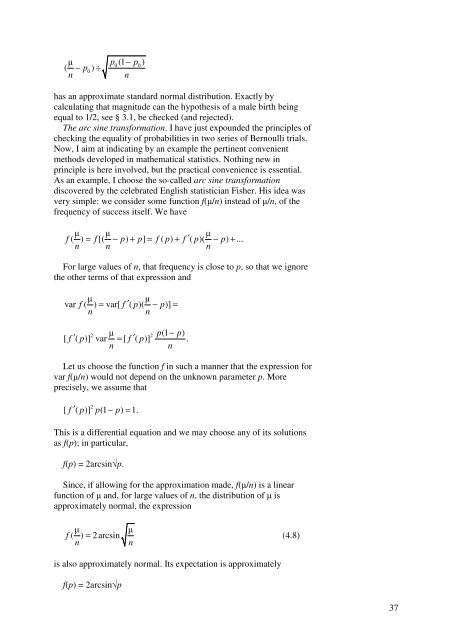1 Studies in the History of Statistics and Probability ... - Sheynin, Oscar
1 Studies in the History of Statistics and Probability ... - Sheynin, Oscar
1 Studies in the History of Statistics and Probability ... - Sheynin, Oscar
Create successful ePaper yourself
Turn your PDF publications into a flip-book with our unique Google optimized e-Paper software.
µ( − p0) ÷np0 (1 − p0)nhas an approximate st<strong>and</strong>ard normal distribution. Exactly bycalculat<strong>in</strong>g that magnitude can <strong>the</strong> hypo<strong>the</strong>sis <strong>of</strong> a male birth be<strong>in</strong>gequal to 1/2, see § 3.1, be checked (<strong>and</strong> rejected).The arc s<strong>in</strong>e transformation. I have just expounded <strong>the</strong> pr<strong>in</strong>ciples <strong>of</strong>check<strong>in</strong>g <strong>the</strong> equality <strong>of</strong> probabilities <strong>in</strong> two series <strong>of</strong> Bernoulli trials.Now, I aim at <strong>in</strong>dicat<strong>in</strong>g by an example <strong>the</strong> pert<strong>in</strong>ent convenientmethods developed <strong>in</strong> ma<strong>the</strong>matical statistics. Noth<strong>in</strong>g new <strong>in</strong>pr<strong>in</strong>ciple is here <strong>in</strong>volved, but <strong>the</strong> practical convenience is essential.As an example, I choose <strong>the</strong> so-called arc s<strong>in</strong>e transformationdiscovered by <strong>the</strong> celebrated English statistician Fisher. His idea wasvery simple: we consider some function f(µ/n) <strong>in</strong>stead <strong>of</strong> µ/n, <strong>of</strong> <strong>the</strong>frequency <strong>of</strong> success itself. We haveµ µ µf ( ) = f [( − p) + p] = f ( p) + f ′( p)( − p) + ...n n nFor large values <strong>of</strong> n, that frequency is close to p, so that we ignore<strong>the</strong> o<strong>the</strong>r terms <strong>of</strong> that expression <strong>and</strong>µ µvar f ( ) = var[ f ′( p)( − p)]=nnµ p(1 − p)′ ′nn2 2[ f ( p)] var = [ f ( p)] .Let us choose <strong>the</strong> function f <strong>in</strong> such a manner that <strong>the</strong> expression forvar f(µ/n) would not depend on <strong>the</strong> unknown parameter p. Moreprecisely, we assume that′ − =2[ f ( p)] p(1 p) 1.This is a differential equation <strong>and</strong> we may choose any <strong>of</strong> its solutionsas f(p); <strong>in</strong> particular,f(p) = 2arcs<strong>in</strong>√p.S<strong>in</strong>ce, if allow<strong>in</strong>g for <strong>the</strong> approximation made, f(µ/n) is a l<strong>in</strong>earfunction <strong>of</strong> µ <strong>and</strong>, for large values <strong>of</strong> n, <strong>the</strong> distribution <strong>of</strong> µ isapproximately normal, <strong>the</strong> expressionµ µf ( ) = 2arcs<strong>in</strong>(4.8)nnis also approximately normal. Its expectation is approximatelyf(p) = 2arcs<strong>in</strong>√p37









